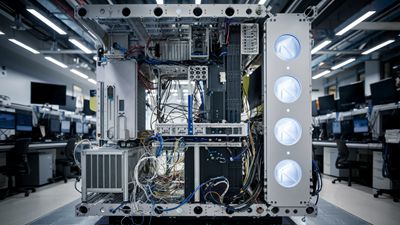Nintendo (NTDOY): Can New Hardware and Game Releases Drive a Comeback?
Financial Performance and Market Position
Recent Financial Results
Nintendo’s recent financial performance has been mixed. As of August 2024, the company reported earnings of $0.11 per share for the quarter ending August 2, surpassing analysts’ expectations of $0.09. However, revenue for the quarter was $1.58 billion, falling short of the forecasted $1.71 billion. This discrepancy highlights a potential issue in revenue generation despite better-than-expected earnings per share (EPS).
The Q1 FY2025 report revealed a significant impact on sales and net profit, with a 46.5% drop in net sales and a 55.3% decrease in net profit. Hardware sales fell by 46.3%, and software sales declined by 41.3%. These figures indicate a challenging period for Nintendo, primarily attributed to a quieter release schedule compared to the previous year.
Stock Performance
As of August 29, 2024, Nintendo’s stock was priced at $13.53, with a market capitalization of $70.29 billion and a price-to-earnings (P/E) ratio of 18.53. The stock has shown a year-to-date increase of 4.2%, starting the year at $12.99. Despite this growth, investor sentiment has recently decreased, indicated by a significant 126.63% increase in short interest.
Analyst Ratings and Projections
Wall Street analysts have given Nintendo a “Moderate Buy” rating. The stock forecast for 2024 indicates a projected earnings growth of 16.98%, with EPS expected to rise from $0.53 to $0.62. Analysts project that Nintendo will post an EPS of $0.53 for the current fiscal year. Despite the recent financial challenges, some analysts maintain a buy rating on Nintendo stock, citing potential boosts from upcoming game releases and new hardware.
Market Trends and Competitive Landscape
Gaming Industry Outlook
The gaming industry is poised for significant growth in 2025, driven by anticipated releases such as Grand Theft Auto 6 and the next Nintendo console, commonly referred to as the Switch 2. Analysts predict a “rebound” for the industry after a challenging period, with a long-term optimistic outlook.
Competition and Consumer Preferences
Nintendo faces increased competition in the gaming industry, with major players like Sony and Microsoft continually innovating and expanding their market share. Additionally, changing consumer preferences and currency fluctuations pose risks to Nintendo’s future performance. Despite these challenges, Nintendo’s strong brand presence and loyal customer base provide a solid foundation for future growth.
Strategic Initiatives and Future Prospects
Upcoming Hardware and Game Releases
The anticipated launch of the Nintendo Switch 2 in Q2 2025 is a critical moment for the company. Industry analysts expect the new console to feature cutting-edge hardware and processing power, potentially redefining portable gaming experiences. Key anticipated titles include blockbuster first-party games like the next 3D Mario and mainline Pokémon entries, expected to anchor the new system’s launch.
Financial Projections and Analyst Expectations
For the fiscal year, analysts project an EPS of ¥300.32, compared to ¥421.39 the previous year, with expected total revenues of ¥1,458.11 billion, down from ¥1,671.87 billion last year. Despite these challenges, some analysts maintain a buy rating on Nintendo stock, citing potential boosts from upcoming game releases and new hardware.
Risks and Challenges
Short-Term Risks
The substantial decline in both hardware and software sales poses risks for Nintendo’s stock performance in the near term. The company is facing challenges as it enters the final year of the Switch, with no major movie releases or blockbuster games anticipated to boost sales. Additionally, increased competition, currency fluctuations, and changing consumer preferences could impact future performance.
Long-Term Challenges
In the long term, Nintendo must navigate the competitive landscape and adapt to evolving consumer preferences. The success of the Switch 2 and upcoming game releases will be crucial in maintaining its market position. Additionally, the company must address potential supply chain issues and production costs to avoid launch shortages and ensure a successful rollout of new hardware.
Actionable Insights and Recommendations
Strategic Game Releases
To mitigate the impact of a quieter release schedule, Nintendo should strategically time the release of major titles to coincide with the launch of the Switch 2. This approach will help maintain consumer interest and drive sales. Additionally, leveraging popular franchises like Mario and Pokémon can provide a significant boost to revenue.
Diversification and Innovation
Nintendo should continue to diversify its product offerings and explore new gaming experiences, such as virtual reality and augmented reality. Investing in innovative technologies and expanding its digital sales platform can help the company stay competitive and attract a broader audience.
Strengthening Global Presence
Given that 74.2% of Nintendo’s sales are made overseas, with the Americas contributing 44.8%, the company should focus on strengthening its global presence. This can be achieved through targeted marketing campaigns, strategic partnerships, and localized content to cater to diverse consumer preferences.
Financial Management and Cost Control
To address potential financial challenges, Nintendo should implement robust financial management and cost control measures. This includes optimizing production processes, managing supply chain risks, and maintaining a healthy dividend payout ratio to ensure long-term financial stability.
Conclusion
Nintendo Co., Ltd. remains a key player in the global gaming industry, with a strong brand presence and innovative product offerings. Despite recent financial challenges and a significant decline in sales, Wall Street analysts maintain a cautiously optimistic outlook for the company’s future. The anticipated launch of the Switch 2 and strategic game releases are expected to drive growth and revenue in the coming years.
By strategically timing game releases, diversifying its product offerings, strengthening its global presence, and implementing robust financial management measures, Nintendo can navigate the competitive landscape and maintain its market position. While short-term risks and challenges exist, the company’s long-term prospects remain promising, driven by innovation and a loyal customer base.
In summary, Nintendo’s future hinges on its ability to adapt to market trends, leverage its strong brand, and deliver innovative gaming experiences. With careful planning and strategic execution, the company is well-positioned to capitalize on upcoming opportunities and achieve sustained growth in the dynamic gaming industry.


